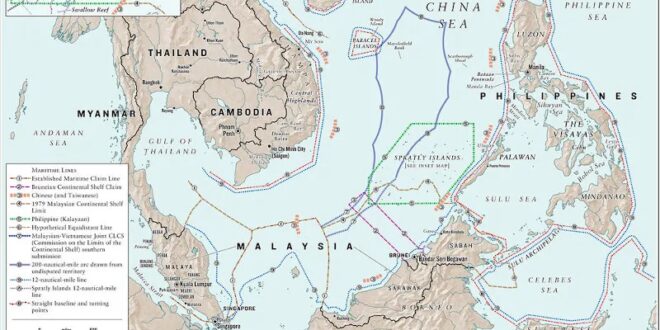The South China Sea has become a problematic arena, with rising tensions between several states, mainly China and its neighbours. The conflict over this strategically important territory has evolved into a complicated and multifaceted issue. In this essay, we will look at the origins of the South China Sea conflict, China’s claims to the entire region, and the numerous reasons that are leading to escalating regional tensions.
To understand the contemporary South China Sea dispute, one must first go back in time. China’s claim to the South China Sea dates back millennia, when Chinese emperors deployed explorers and officials during the Han Dynasty (2nd century) and maintained territorial claims in the Nansha (Spratly Islands) and Xisha (Paracel Islands) chains during the Song Dynasty. These historical documents form the basis for China’s claim to maritime territory.
However, the arrival of Western colonial powers in Southeast Asia in the 16th century, together with the development of the Vietnamese Nguyen Dynasty in the 19th century, called China’s historical dominance into question. The occupation of major Chinese cities by Japan in the early twentieth century exacerbated the problem. China’s claims evolved, culminating in the eleven-dash line on its national map in 1947, which included the Gulf of Tonkin. This allegation was made by China’s then-Nationalist administration.
The current South China Sea conflict is centred on China’s insistence on the so-called “nine-dash line,” which encircles practically the entire sea. This assertion contradicts the United Nations Convention on the Law of the Sea (UNCLOS), which establishes Exclusive Economic Zones (EEZs) 200 nautical miles from a country’s coast. Brunei, Indonesia, Malaysia, the Philippines, Taiwan, and Vietnam all have competing territorial claims in the South China Sea. The conflict has been exacerbated by the potential wealth of undeveloped oil and natural gas resources, estimated at 11 billion barrels and 190 trillion cubic feet, respectively.
Since 2002, the Association of Southeast Asian Nations (ASEAN) has attempted to adopt a code of conduct to reduce conflicts over maritime claims, but progress has been slow. China has bolstered its territorial claims by building infrastructure on rocks and islets, upgrading military facilities, and sending coast guard, maritime militia, and fishing fleets.
In 2016, the Permanent Court of Arbitration in The Hague decided in favour of the Philippines, declaring that the UN Convention on the Law of the Sea supersedes any historic or sovereign rights that extend beyond the treaty’s bounds. In other words, the tribunal determined that the nine-dash line did not provide a foundation for China’s vast claims. Despite this decision, Beijing has continued to assert its sovereignty in the South China Sea by building artificial islands and deploying a variety of marine capabilities.
A number of factors are contributing to the escalation of tensions in the South China Sea. For starters, the region has turned into a crucial battleground for geopolitical rivalry, with both China and the United States, as well as other regional players, competing for supremacy. The United States has conducted Freedom of Navigation Operations (FONOPs) to dispute China’s territorial claims, forcing China to respond with increased military deployment.
Second, the South China Sea’s huge oil resources provide a powerful economic incentive for claimant states to enforce their territorial rights. The potential richness of untapped oil and natural gas reserves has exacerbated tensions between these countries. Nationalism is an important factor in the ongoing tensions, with nationalistic attitudes prevalent not only in China but also in other claimant countries. This spike in nationalism has resulted in rigid attitudes, making diplomatic resolutions increasingly difficult to achieve.
The collision between China’s historical claims and international legal rules, particularly those stated in the United Nations Convention on the Law of the Sea (UNCLOS), complicates the South China Sea dispute even further. This unresolved disparity has hampered the development of a unified framework for marine boundary and territory disputes. Military expansion has also raised worries in the region, as numerous claimants have militarised manmade islands. While China’s military infrastructure construction has received considerable attention, other countries have also pursued military-oriented initiatives, contributing to a climate of military competition.
Finally, a diplomatic impasse has prevailed, owing to the unwillingness of the parties involved to negotiate and compromise. China’s unwillingness to recognise the 2016 arbitration verdict that rejected its vast territory claims has aggravated the problem, making diplomatic solutions appear elusive.
The South China Sea dispute is complicated by historical claims, economic interests, and geopolitical rivalries. China’s claim of the nine-dash line, which contradicts UNCLOS, has heightened tensions in the region. The involvement of many claimant states, the militarization of the area, and the lack of a clear resolution process all contribute to the situation’s complexity. As long as these challenges persist and the South China Sea remains a centre of regional and global geopolitical conflict, reaching a peaceful and diplomatic settlement remains a tough endeavour.
 Eurasia Press & News
Eurasia Press & News




